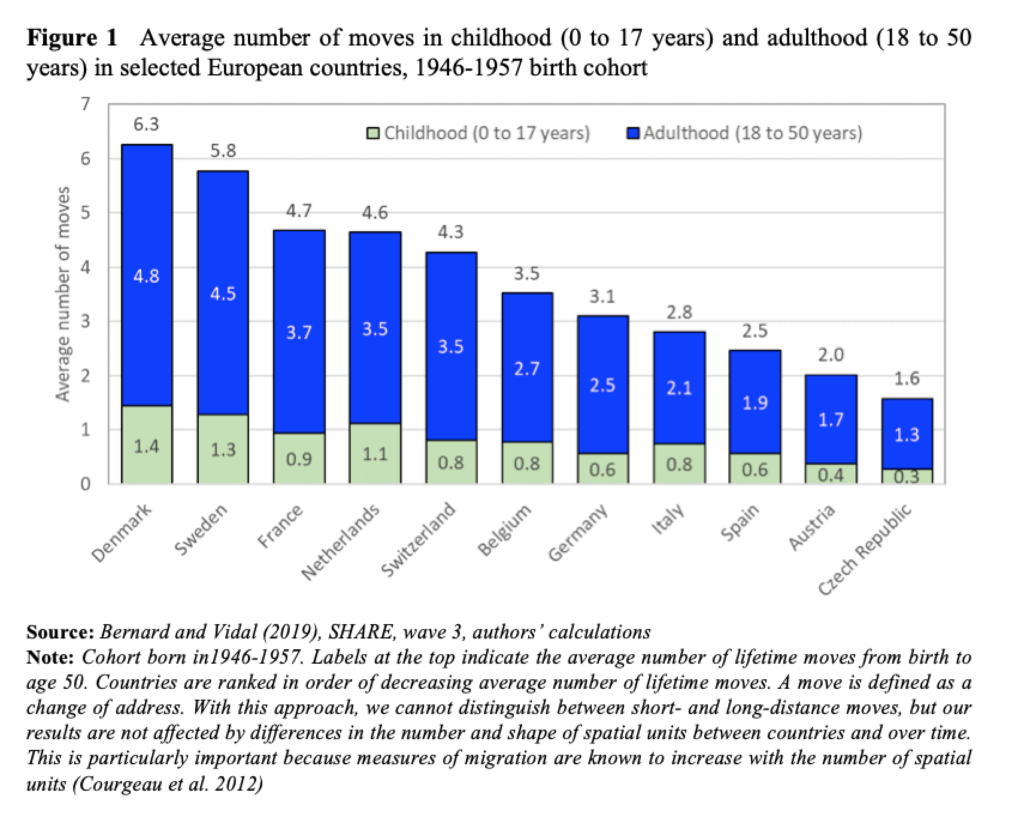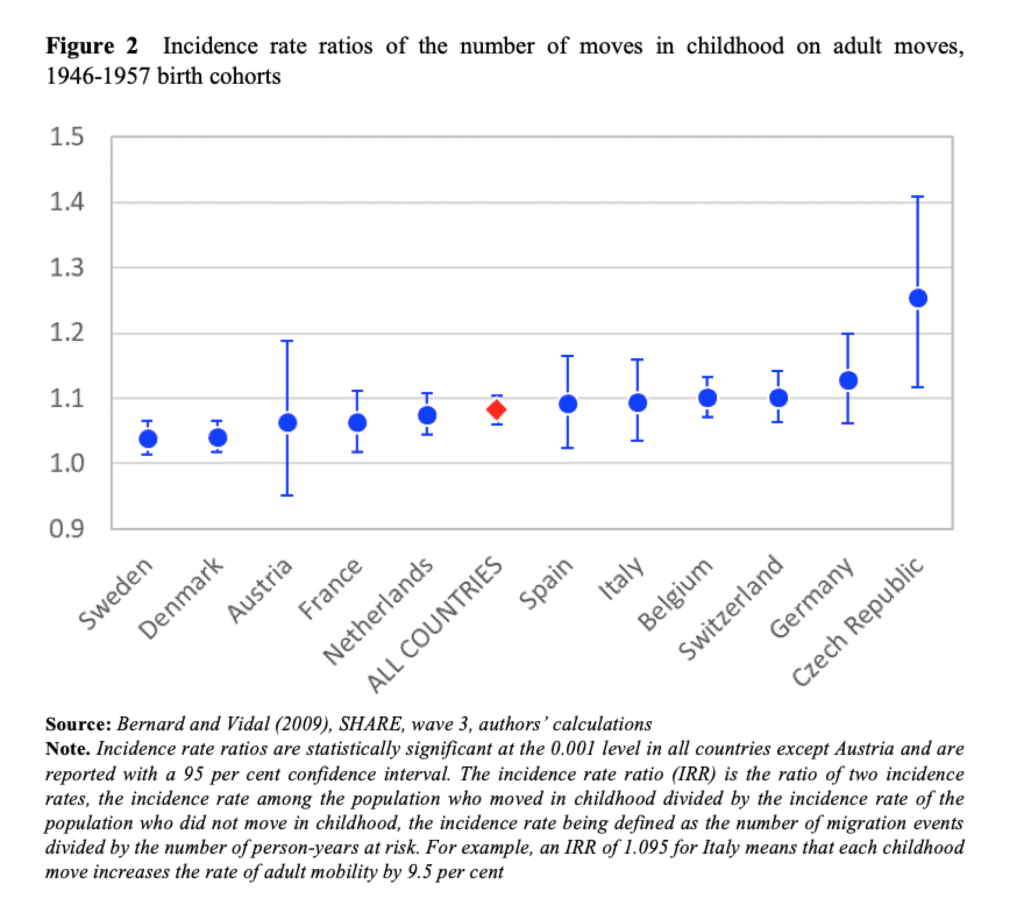Aude Bernard and Sergi Vidal investigate the impact of childhood moves on internal migration behaviour in adulthood in 11 European countries. They find that childhood moves significantly increase the likelihood of moving in adulthood,
particularly in low mobility countries in the south, east and centre of Europe where moving as a child is less common. This could reinforce diverging trends in internal migration levels across Europe.
Introduction
Migration plays an increasingly important role in the transformation of national, regional and local populations. In this respect, internal movements are more important than international ones, because the former outnumber the latter by a factor of four to one globally. Changing region of residence within a country derives from a complex, multifaceted decision process aimed to maximise opportunities under a set of resources and constraints (White 2016). It has been shown that the migration decision-making process is shaped by previous migration experiences. In particular, the likelihood of migrating increases inversely with age at first adult migration (Bernard 2017) and directly with the number of past moves in adulthood (Clark and Lisowski 2018). These recent findings suggest a path dependency in individual migration trajectories. Understanding this complex process is important, particularly in Europe where countries appear to be following diverging trends, with some recording a decline in the level of internal migration and others showing stability or increase (Bell et al. 2018).
Migration and residential mobility have been shown to affect cognitive and behavioural development in childhood, with consequences on well-being later in life (Lennon et al. 2016). However, it is unclear from the psychology literature whether childhood relocations increase or decrease the propensity to move in adulthood. On the one hand, because migration is disruptive to a child’s life, prospective migrants may view migration negatively and be less inclined to move as adults. On the other hand, moving to a new location can provide children with new opportunities and skills: acknowledging these benefits, individuals may be more willing to move in later life.
To test these hypotheses, we drew on life histories collected retrospectively from a cohort of baby-boomers in wave 3 of the Study of Health, Ageing and Retirement in Europe (SHARE), a nationally-representative survey of the population aged 50 years and over. We examined how the timing and number of changes of residence in childhood shaped adult mobility behaviour between ages 18 and 50 years in 11 European countries for a cohort of baby boomers born between 1946 and 1957.
Internal migration levels in European countries
We found a marked north-south and east-west gradient, with high levels of lifetime mobility in Denmark, Sweden, France and the Netherlands that decrease southwards and eastwards, reaching low levels in Italy, Spain, the Czech Republic and Austria. These results conform closely to the spatial patterns identified in previous comparative studies. Not surprisingly, in countries where adulthood mobility was low, (their) children’s mobility was also low. In Austria and the Czech Republic, the proportion of child non-movers is above 70 per cent. In contrast, in countries at upper-intermediate levels of mobility, such as the Netherlands and France, about 40 percent remained immobile, while in the two most mobile countries, Denmark and Sweden, only about a third of children did not move. (Figure 1)

Impact of childhood moves
Figure 2 shows that when all countries are modelled jointly, each successive childhood move increases the number of adult moves by 8.14 percent. When models are run separately for each country, the coefficients remain statistically significant in all countries except Austria. The effect of childhood moves is particularly pronounced in low mobility countries in the south, east and centre of Europe where moving as a child is less common. By looking into childhood moves separately by age, we also showed that each successive childhood move increases the likelihood of moving as an adult in a broadly linear fashion. Our findings also suggest that changing residence in adolescence is particularly influential, but in some countries, pre-school relocations have a lasting effect on subsequent mobility. This suggests that the very first move in life may exert a particular influence by exposing a child for the first time to the intricacy of moving and the social disruption that it creates, thus having long-term consequences on mobility behaviour.

Implications for future migration trends
A continuous decline in levels of internal migration have been observed in some countries in Europe, the United States and North America and Australasia over the last three decades (Champion, Cooke and Shuttleworth 2018). This downward trend means that a decreasing proportion of children are migrating with their parents, with consequences not only on current but probably also on future migration levels, thus perpetuating a decline in internal migration. This evolution is likely to be particularly pronounced in low mobility countries, such as Hungary, Germany and the Russian Federation, where migration has declined since the 1990s (Bell et al. 2018). The impact of a downward trend is expected to be weaker in highly mobile countries, such as the Netherlands and Iceland, as our results show that the impact of childhood mobility on subsequent moves is weaker in high mobility countries. This downward trend is by no means universal, however, as some European countries – both high mobility countries such as Ireland, Norway and Finland, and low mobility countries such as Austria, Belarus, the Czech Republic, Greece and Estonia – have seen an upturn in their levels of internal migration since the 1990s (Bell et al. 2018). Increased migration among children in these countries might, in turn, increase their likelihood of migrating later in life, thereby raising future migration levels and reinforcing diverging trends in internal migration among European countries.
References
Bell, M., Charles-Edwards, E., Bernard, A., & Ueffing, P. (2018). Global trends in internal migration. In T. Champion, T. Cooke, & I. Shuttleworth (Eds.), Internal Migration in the Developed World: Are we becoming less mobile? (pp. 76-97). London: Routledge.
Bernard, A., & Vidal, S. (2019). Does moving in childhood and adolescence affect residential mobility in adulthood? An analysis of long-term individual residential trajectories in 11 European countries. Population, Space and Place, 26(1), 1-16
Bernard, A. (2017). Cohort measures of internal migration: Understanding long-term trends. Demography, 54(6), 2201-2221.
Champion, T., Cooke, T., & Shuttleworth, I. (2018). Internal Migration in the Developed World: Are we becoming less mobile? London:Routledge.
Clark, W. A., Lisowski, W. J. P., Space, & Place. (2018). Examining the life course sequence of intending to move and moving. Population, Space and Place, 24(3), e2100.
Courgeau, Daniel, Salut Muhidin, and Martin Bell. “Estimating changes of residence for cross-national comparison.” Population 67.4 (2012): 631-651.
Lennon, M. C., Clark, W. A., & Joshi, H. (2016). Residential mobility and wellbeing: exploring children’s living situations and their implications for housing policy. Longitudinal and Lifecourse Studies, 7(3), 197– 200.
White, M. J. (Ed.) (2016). International Handbook of migration and population distribution. Dordrecht: Springer.


